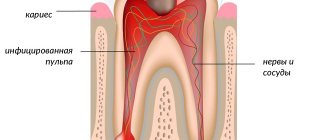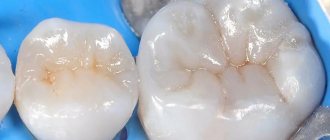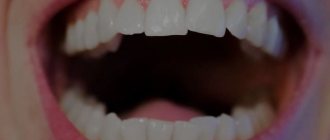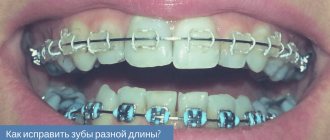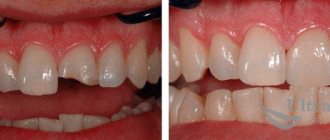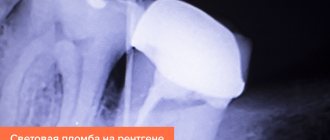Author of the article:
Soldatova Lyudmila Nikolaevna
Candidate of Medical Sciences, Professor of the Department of Clinical Dentistry of the St. Petersburg Medical and Social Institute, Chief Physician of the Alfa-Dent Dental Clinic, St. Petersburg
Enamel is the hardest part of the tooth. This tissue consists of enameloblasts, proteins, lipids and water. Although, at first glance, the enamel has a uniform structure, this is not the case. It varies in thickness in different areas of the teeth. But, unfortunately, even the strongest enamel on teeth can begin to wear off. How to prevent this unpleasant process? Let's try to figure it out.
Content
- When should you start taking care of your teeth?
- Why does enamel wear off?
- What to do if the enamel wears off
- The enamel is worn off, teeth hurt - what to do?
- Solving the problem yourself
Poor dental health can cause dangerous illnesses. The health of these organs is especially important in a person’s life, since any food must be chewed well, and with unhealthy or missing teeth this is not easy. The front teeth experience high stress when eating food, and it is important that their enamel is complete. Worn enamel, among other things, deprives a person of the opportunity to smile, and his attractiveness is lost.
Methods for restoring tooth enamel
If there are signs such as the appearance of cracks on the surface of the teeth, dark spots, pain when eating hot, cold, sour or sweet foods, yellowing of the teeth, then you need to consult a dentist. Self-treatment can be carried out, but only at the initial stage and after consultation with a doctor.
The main methods used in dentistry:
- Application of fluoride varnish. Fluoride gel creates a protective film.
- Deep fluoridation. Compositions with fluorine and other minerals are used to saturate the teeth with valuable elements. The drug penetrates deeply into pores, enamel cracks, dentin channels and seals them.
- Remineralization. A procedure similar to fluoridation, but the main component is calcium.
- Implantation. Extension using a composition that is as similar as possible to natural enamel. The mixture adheres to the tissues of the dental unit at the molecular level, providing long-term protection. The procedure is new, but available in Moscow, St. Petersburg and other large cities.
- Aesthetic restoration. If there are deep cracks or chips, then the surface of the teeth is restored with composite materials.
- Veneers. If the defects on the front teeth are very pronounced, they are hidden with thin plates. The enamel is ground down and then veneers are installed.
The last two methods are irreversible, since the dental tissues are ground down, so they are used in cases of significant damage to the enamel. The cost of procedures depends on the type of drugs used, materials, scope of work and other factors.
When should you start taking care of your teeth?
The correct answer is from the prenatal period. It is from this time that the expectant mother should saturate her body with vitamins and calcium and take vitamin and mineral complexes specially created for pregnant women. A professional dentist will help in this matter.
Breastfeeding is important for a newborn baby, because mother's milk will provide the baby with everything necessary for proper development, including teeth.
When the child gets older, parents introduce him to sweets - this is the first factor that destroys teeth. From this moment on, there is a danger of caries. If there is not enough calcium, the enamel will be destroyed in childhood.
To avoid such danger, the mother must:
- Reduce consumption of sugar and fructose;
- Protect yourself from any diseases so as not to cause hypoplasia in the unborn child - underdevelopment of tooth enamel;
- Feed your baby breast milk, because the share of sugar in infant formula is up to 30%;
- Minimize the amount of cookies and sweets in the child’s diet;
- Take vitamins as prescribed by your dentist.
Teeth wear for physiological reasons
When does the process of tooth wear begin?
The process of wearing away tooth enamel begins almost immediately after teeth erupt. This is natural and normal, as it allows the body to adapt to the resulting load. Physiological abrasion is necessary so that the load on the teeth and jaws is distributed evenly and there is no overload of individual areas. Point contacts of teeth turn into planar contacts and the angle of inclination of the teeth changes. This is necessary for a more physiological functioning of the dentofacial apparatus.
It is important to understand that proper physiological tooth wear affects only the outer enamel, without damaging the inner dentin, and occurs only at the points of contact of the teeth.
Wearing of baby teeth in children
Not only molars and permanent teeth in adults wear out, but also baby teeth in children. By about four years of age, the child’s teeth on the incisors, as well as the cusps on the canines and chewing teeth, completely wear out. It is considered normal for the enamel to wear away by the age of six, even down to the dentin.
And in the period until the complete change of baby teeth - up to 13-14 years, the dentinal layer may also be worn out.
Increased abrasion is considered when the tooth cavity becomes visible or the tooth crown is lost.
Why does the enamel on teeth wear off?
Scientists identify several reasons:
- Bad habits - biting pencils and nails, alcohol and nicotine;
- Straight bite;
- Sharp closing of the jaws during stress, bruxism;
- Violation of metabolic processes;
- Work in hazardous industries - in the field of metallurgy, in coal mining, in confectionery shops;
- Using brushes with hard bristles;
- Inappropriate bleaching;
- Culinary preferences (hot tea with ice cream, for example).
PROMOTION
Hygienic teeth cleaning
2000 rub.
Prevention of enamel destruction
Dentists' recommendations:
- brush your teeth twice a day, additionally use irrigators;
- use toothbrushes with medium-hard bristles, replace them with new ones every 3-4 months;
- rinse your mouth after eating;
- give up bad habits (smoking, chewing pens, opening bottles with your teeth);
- include dairy products and sea fish in your diet;
- massage the gums;
- do not abuse whitening procedures;
- treat dental diseases in a timely manner;
- Once a year, or better yet every six months, undergo a preventive examination with a dentist.
Following simple rules will significantly reduce the risk of damaging the protective layer of the tooth.
Enamel has worn off, teeth hurt – what to do?
Seek help from a dentist and begin treatment. Various methods and drugs are used to eliminate the problem. It is impossible to restore the enamel, but the use of drugs will make it harder and protect it from further destruction. Scientists are working to create drugs that can restore worn enamel. The implementation of this task will be a truly great discovery.
How to care for teeth enamel after polishing and whitening
The thickness of the protective cover varies from 2 to 2.5 mm. With thinning, increased sensitivity appears. Taking care of your teeth after professional cleaning or polishing will not only prolong the effect, but also allow you to experience less discomfort. During such procedures, the protective layer becomes very thin and, if not properly cared for, its structure may be damaged.
Dentists recommend using toothpastes to reduce tooth sensitivity and regularly using special rinses and dental floss. Immediately after the procedure, it is strictly forbidden to smoke or drink drinks that are too hot or too cold. At night, they may recommend wearing a mouth guard with a special gel. Increased sensitivity in the first days after the procedure is a standard side effect.
Care after teeth whitening includes a “white diet”. It is prohibited to consume foods with high concentrations of coloring substances. This includes wine, coffee, berries, colored vegetables and fruits, soda, spices, and products with a high cocoa content. Sticking to a strict diet is especially important in the first two weeks after whitening.
It is recommended to consume more fish, white meat, egg whites, dairy products and rice. All foods that can damage the thinned surface are excluded from the diet. Strictly monitor the temperature, as changes will negatively affect the appearance and health of the oral cavity. All restrictions are introduced only for the first 14 days after the dental procedure.
Hyperesthesia interferes with the usual way of life. It is painful to eat and drink, and discomfort occurs when the temperature changes. Fluoridation may be needed. The disease must be treated only under the supervision of a specialist. It is important to exclude products that are harmful to enamel and follow hygiene rules.
How to detect the disease in time
Erosion on the enamel should be treated immediately. The disease can progress very quickly and within a few months completely destroy not only the surface of the tooth, but also the dentin, leaving the pulp exposed.
There are three main stages of pathology.
- First. This is the initial stage, during which it is difficult to independently detect signs of dental damage. During examination, the dentist may detect a loss of shine and a change in the shade of the enamel.
- Second. At the middle stage, more pronounced signs already appear indicating increased sensitivity of the enamel: reaction to food (salty/sweet, hot/cold, spicy, etc.). Pigmentation becomes obvious.
- Third. It is considered a deep and advanced stage. Part of the enamel may be completely missing. Dentin is exposed. Brown or yellow spots are visible on the preserved surface of the tooth.
The disease is also classified according to the nature of its course. There are two forms: active and stable. In the active form, the disease progresses quickly with a characteristic change in the color and structure of the enamel. The stable form is characterized by the absence of symptoms and restoration of enamel using the body’s resources.
Treatment tactics
Hypoplasia of the enamel of primary or permanent teeth is irreversible. Therefore, all therapeutic measures are aimed at protecting the altered areas of the dentition and restoring the enamel coating. Mild pathology does not require special treatment, but only requires constant monitoring. In most cases, a person does not experience pain: non-carious changes in dental tissues do not interfere with everyday life.
For severe forms of hypoplasia, for example, deep lesions of the enamel or extensive spots, special therapy is carried out. Without timely treatment, there is a risk of developing various complications:
- pulpitis, periodontitis;
- malocclusion;
- pathological abrasion;
- increased sensitivity of teeth.
Hypoplasia can also lead to dentin destruction and complete tooth loss. There are several methods for eliminating the manifestations of hypoplasia. Therapeutic tactics are selected by the dentist depending on the severity of the pathology. The doctor takes into account the condition of the patient’s dental tissues.
Remineralization
Remineralizing therapy involves saturating tooth enamel with fluoride and calcium. Artificial mineralization is carried out using dental gels, pastes, varnishes and other means. Treatment can be done in a clinic or at home.
Remineralization in a clinical setting consists of several stages:
- Professional oral hygiene.
- Application of restorative gel.
- Coating with a fluorine-containing compound using a tray or brush.
The dentist selects the frequency of procedures and the type of drug individually. In addition, your doctor will often prescribe oral vitamins and minerals as additional support for your body.
Whitening
Bleaching is carried out after professional hygiene and remineralizing therapy. This method is effective if the defects are located in the surface layers of the enamel or slight clouding of the enamel layer is observed. Chemical bleaching gives the most pronounced results.
In cases of severe damage to the enamel layer and numerous foci of hypoplasia, chemical bleaching with solutions of carbamide peroxide and hydrogen peroxide is contraindicated.
Filling and prosthetics
Filling is used for pronounced erosive depressions, as well as mixed forms of hypoplasia, when the integrity of the dental units is compromised. Composite materials are used to restore teeth. In some cases, the vestibular surface is covered with veneers. This technique helps to give teeth an aesthetic appearance and prevent their destruction.
Prosthetics are used for severe damage to the enamel of primary or permanent teeth. Crowns help maintain the health and aesthetics of your teeth. Installing crowns for hypoplasia in childhood contributes to the formation of a correct bite and the development of normal diction.
Depending on the extent of the damage, the condition of the soft and hard tissues, it may be necessary to remove the affected tooth followed by implantation.
Diagnostics
This disease can be diagnosed during a dental examination. The dentist detects the location of the erosive focus by thoroughly drying the tooth surface with a stream of air and lubricating it with 5% iodine tincture. The area of enamel affected by the disease becomes brownish in color.
Erosion differs from other pathological processes in its contours, localization, smooth surface and is usually located closer to the base of the root.
The earlier the pathology is diagnosed, the more successful its treatment will be.
The consequences of erosion are dire
Erosion affects mainly middle-aged people. This process is characterized by a long-term course and can last from 10 to 15 years. The following consequences of damage to tooth enamel can be identified:
- Tooth wear accelerates.
- As dentin is exposed, the color of the teeth changes and they become darker.
- As the enamel wears away, the sensitivity of the teeth on the inner and outer surfaces worsens, that is, touching the tongue and lips brings discomfort. Dentin is a soft tissue, so pain will inevitably occur when air enters, chewing and exposure to food acid contained in food.
- The edges of the front teeth may appear more translucent.
How to restore enamel at home
to restore tooth enamel at home, but under the supervision of a doctor. You can create the conditions for enamel restoration on your own.
Recommendations
- plan your diet wisely, avoid dangerous diets (eat more dairy products, especially cottage cheese and cheeses, as well as vegetables, herbs and fish);
- choose the right oral hygiene products (these must be pastes, gels and rinses that contain calcium and fluoride);
- reduce the amount of sour and sweet products;
- drink clean water (unlike tea, coffee and other drinks, water protects our teeth and does not destroy them);
- eliminate problems with nasal breathing. Mouth breathing causes the mouth to dry out. Dry teeth are more susceptible to caries.
Causes of pathological abrasion
There are several main reasons for the development of abrasion pathology, and in the first place among them are bad human habits. For example, the habit of gnawing seeds, holding small objects in the mouth (pins, cloves, pipe mouthpiece), love for foods with high acidity may well become catalysts for the process.
Often the cause of increased abrasion is diseases: bruxism, diseases of the gastrointestinal tract, nervous, cardiovascular, endocrine systems, from the side of the TMJ - malocclusion. The cause may also be improper dental treatment - an incorrectly manufactured orthopedic design can provoke severe abrasion of the antagonist tooth.
Sometimes the cause of pathology may be the chosen profession. Some employees of the metallurgical, cement, granite industries, and representatives of the mining workshop suffer from increased abrasion.
Manifestations of erosion depending on the stage
The process of development of the disease is very rapid and dangerous, since along with erosion, pathological abrasion of the hard tissues of the tooth develops.
The disease is chronic, which progresses more and more over time and affects healthy teeth.
Symptoms as the destruction progresses:
- At the primary stage, there is a loss of shine of tooth enamel in the area of a certain area of the tooth surface. At this time, it is almost impossible to identify the process of erosion development. This can only be done by drying the tooth surface with an air stream or by applying iodine to the affected area, in which case the erosive area will turn brown. Initially, the erosive defect will have an oval or round shape with a smooth bottom. The erosion is whitish in color. There is no pain.
- At the second stage, discomfort and a change in color of the affected area begin to appear.
- At the last stage, noticeable pain appears during eating and brushing teeth. The pigmentation of the affected areas changes. Brown spots on the surface of the tooth become noticeable.
Stages and phases of destruction development
The disorder is classified not only by stages of development, but also by phases:
- The active phase is characterized by a progressive process of loss of tooth tissue, which causes excessive susceptibility of teeth to the action of various irritants. The enamel is destroyed very quickly, the size of the erosion increases every month.
- The stabilized phase occurs very slowly. Characterized by less severe pain. This is due to the fact that as the defect forms, the formation of tertiary dentin is observed, which is a product of the vital activity of the pulp and acts as a kind of protective barrier.
It is very important that in some cases the disease may transition from one phase to another.
There are 3 stages of disease development:
- initial, there is damage to the purely upper layer of enamel;
- medium, the enamel is affected so deeply that erosion reaches the dentin;
- deep, the enamel is completely affected, and the upper layer of dentin is also affected.
How is pathology determined?
Only a specialist can detect a violation during tooth wear. Of course, the general picture among the population is taken as the norm, but the doctor also takes into account individual factors:
- general condition of the enamel;
- presence or absence of exposed dentin;
- work of the temporomandibular joint;
- condition of the mucous membranes of the tongue and cheeks;
- degree of severity of nasolabial folds;
- sensitivity of the masticatory muscles.
It is interesting that in addition to all the individual characteristics, the doctor is interested in the sound with which the jaws close. A sharp, clear and short sound indicates that there are no problems. A long-lasting sound accompanied by a squeak indicates deficiencies in the functioning of the TMJ or problems with the nervous system.
You can understand that teeth are subject to increased abrasion by the first sign - increased sensitivity. It is sharper when the upper hard layer of enamel is significantly abraded.
